Harbour:The methadone approach to market recovery
In its latest fixed interest commentary Harbour Asset Management argues that quantatative easing will be the key factor driving the market this year. However at some point the US Federal Reserve will need to be cautious about withdrawing the drug from the patient.
Wednesday, April 4th 2012, 12:26PM
by Harbour Asset Management
Key points:
- While developments in Europe drove NZ fixed interest markets in 2011, the future of the Quantitative Easing (QE) in the US will be a key driver in 2012.
- As the size of QE has grown since the start of the GFC, markets and the economy have become more dependent, increasing the challenge of QE exit.
- The decision as to when to wean the market off QE will depend on the prospects for US unemployment and inflation, which are noticeably better than when the Fed embarked on QE1 and QE2.
- However, the Fed will be cautious about withdrawing the drug from the patient, and attempt to guard against a sharp rise in long-term interest rates before the economy can stand on its own feet.
With little news on the local front to change the RBNZ's intention to keep the Official Cash Rate (OCR) on hold until the end of 2012, the focus of the local fixed interest market has been on global developments.
While developments in Europe drove NZ fixed interest markets in 2011, the future of the Quantitative Easing (QE) in the US will be a key driver in 2012, particularly given the tight relationship between US and NZ government bond yields (Chart 1). Over the course of March there has been heightened speculation about how long the stimulus from QE will remain and when the US Federal Reserve will eventually exit QE.
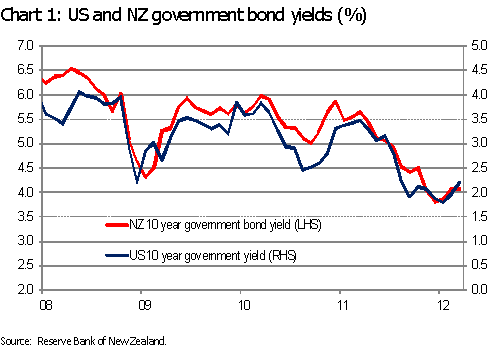
An even bigger challenge than launching QE
In the UK, the Bank of England began QE at the height of the GFC in 08/09. In the months beforehand, staff worked frantically to provide advice on the size of programme required and the mechanics of intervening in the government bond market. As soon as the first purchase was complete, with the same sense of urgency, work turned immediately turned to contingency plans for how to exit and reverse QE. Even at those early stages, experienced central bankers could already sense that the challenge of exiting QE would be even more challenging: the market would have to be weaned off QE delicately, taking a methadone approach.
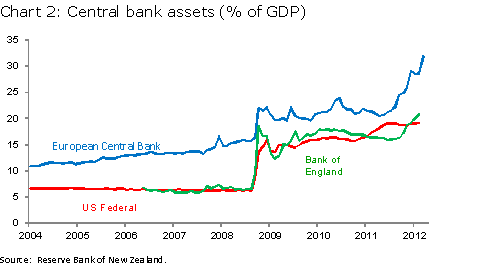
Since the early days of QE, central banks in the UK, US, and Europe have continued to expand their balance sheets at rapid pace over the last 3 years (Chart 2). As a result, the size of the exit problem for central banks has been growing.
The impact on markets can been seen in government bond markets, where real yields are now negative in many core countries, US, Canada, UK, Germany (Chart 3). Investors won't tolerate negative real yields for an extended period, and so are hypersensitive on news about QE, and when central banks (especially the US Federal Reserve) will remove the drug from the market.
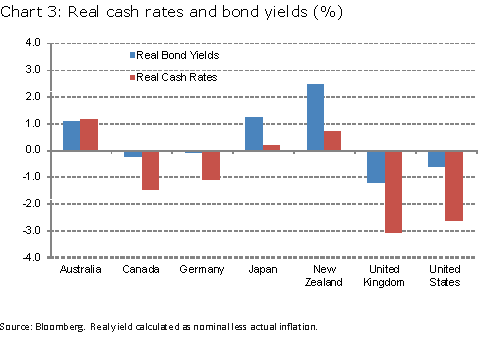
So the US Fed is left with the communication challenge, made more difficult from the fact that US interest rates are set by a committee with differing opinions (Chart 4). While the official message is that interest rates will stay exceptionally low until the end of 2014, the market will continue to hear a cacophony of voices potentially creating more confusion than clarity, to a market already in uncertain territory.
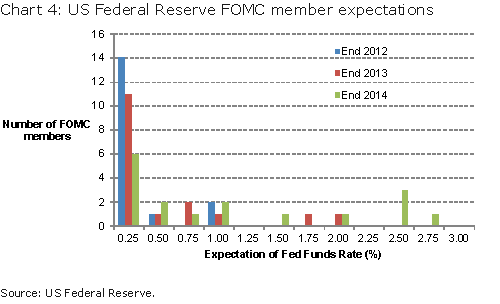
The fact is that the US economic data has been surprisingly robust over the past 6 months (Chart 5), while the US 10 year government bond yield had remained in a remarkably tight range around 2%, effectively held down by the Fed's action.

During March, the US Fed finally acknowledged that the US economy is gradually improving. This saw the US 10 year government bond yield jump to nearly 2.40%, before US Fed officials returned to the airwaves with reminders that the economy is only just taking root. They are acutely aware of the balancing act they face: at some stage they need to get the economy off its QE fix, but they need to do so at a rate the patient can cope without a damaging relapse.
Indeed, there are even some in the market calling for further QE3 once the latest prescription ends in June. Ultimately, the US Federal Reserve will need to make this call on the basis of its dual mandate of full employment and price stability. So how do the patient's symptoms look on those two that fronts?
Developments in the US job market have looked promising. The US economy has been generating around 200,000 non-farm payrolls for a number of months now. But given the extent of job destruction through 2008-09, unemployment remains stubbornly high above 8% (Chart 6). The US Fed will want to see more good progress on this front, with the unemployment rate having to settle closer to 6.5% before it is satisfied. Rather than requiring a further dose of QE, it may just take time for the current degree of stimulus to works its way through the economy's blood system.
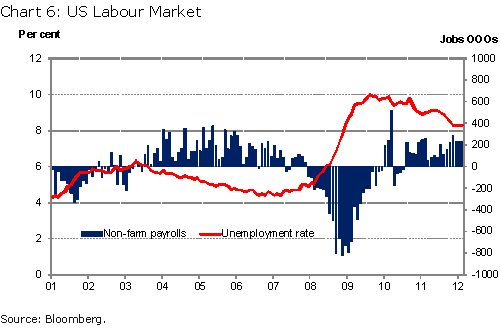
The need for further QE to avoid deflation is even less compelling. When the US Fed began QE there was a genuine fear of deflation. For example, a key factor in prompting the Fed to embark on QE2 was underlying inflation (stripping out volatile food and energy prices) falling below 1% in 2010. But now underlying inflation is sitting more comfortably around 2%, broadly in line with long-term averages (Chart 7). Similarly, market expectations of US inflation derived from the inflation indexed bond market are noticeably higher than the Fed launched QE1, QE2 or Operation Twist.
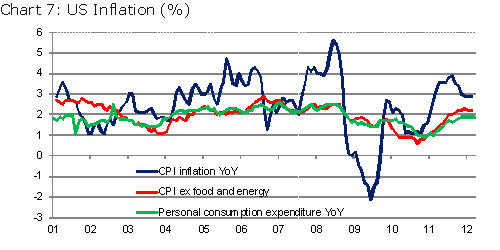
So while the US economy continues its way out of the recovery ward post GFC, we expect the US Federal Reserve to slowly wean the patient off the stimulus that it has been receiving for the past 3 years. However, while the trend will be for higher interest rates, it will be a bumpy road along the way. At times, the patient will display mixed signs of health; at others the US Fed will try to slow the pace at which the market tries to anticipate the recovery.
The speed at which the US Fed withdraws stimulus from the market is critical for fixed interest investors both in the US and New Zealand.
To the extent that Fed acts very slowly, with an upward sloping yield curve there is still an incentive to hold long maturity bonds and receive the yield pick-up over very low official cash rates. But at some stage, as the economic data in the US recovers, bond yields will have to head higher, and that will result in capital losses to holders of long maturity bonds. During those periods of correction, short duration assets with good running yields from credit spreads will help provide protection from capital losses. The key issues are speed and timing, and that will depend on the prospects for US unemployment and inflation.
Important disclaimer information
| « Tyndall: The global economic tour | Tyndall Monthly Commentary » |
Special Offers
Commenting is closed
| Printable version | Email to a friend |









